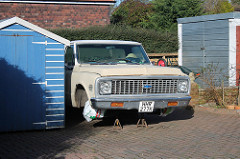Let the Texans have their truck. Leave the rest of us alone. Sedans are also authentic.
-{Originally Appeared on Ordinary Times}-
The New York Times used the truck rodeo to write a piece about pickup trucks in Texas:
“I call it ‘truck-itis,’” said Mr. Spell, the former automotive editor for The Houston Chronicle. “People in Texas will buy trucks even if they’re not going to haul anything heavier than raindrops. I was interviewing one guy. He had a 4-by-4. I said: ‘You live in Houston. Why do you have this 4-by-4?’ He said, ‘Well, I own a bar, and 4-by-4s are higher, and I can climb up on the cab and change out the letters of my marquee.’”
Whether for high-up urban letter-switching or more rural and rugged purposes, pickup trucks are to Texas what cowboy boots and oil derricks are to the state — a potent part of the brand. No other state has a bigger influence on the marketing of American pickup trucks.
Responses to this from the right tended to jeering and a criticism of what is sometimes called “Conservatives in the Mist” coverage of red states and their mysterious ways. Much in particular was made of the above quote and the sneering attitude (never mind that it was from a Texas resident). Maybe some of the criticism was fair, but most of it was kneejerk. The piece was, for the most part, an out-of-town lifestyles piece that introduced people over here to what the people over there were up to. I am attuned to the regional dynamics, and for the most part I found little objectionable. They didn’t even mention global warming, professed by some to be the rationale for the sneer.
More to the point, though, the “criticism” (such as it was) was pretty on target, from my vantage point. I lived in the urban south. Then I moved to the rugged west. One of my earlier observations was how many fewer trucks there were, or medium-heavy to heavy vehicles at all (excepting minivans). That, despite the fact that pickups, SUVs, and so on are actually a lot more useful to a lot more people out there. If you buy a sofa in Colosse, chances are it’s not from very far away and you can rent a UHaul. You’re less likely to need AWD for offroad adventures. Further, the inconveniences of heavier vehicles are much more obvious. Living in the city, parking and maneuverability count for a lot and my experience was “the smaller, the better.” Meanwhile, out west, the ability to haul stuff is more important because you might be buying a couch from 100 miles away, which gets expensive with a UHaul. All-Wheel Drive and a larger frame isn’t critical but can reduce worry for a lot of scenarios that aren’t an issue in the urban south. And few of the drawbacks of owning a bigger vehicle in the city exist in the country, with the exception of gas.

Image by charlie cars 
Which brings us to the undertone that generated so much ire: Texans – and urban southerners more generally – are spending a lot of money to conspicuously consume trucks as a status or self-image item. A statement of desired self. It’s a larger, $30,000 belt buckle that costs you extra money every time you use it. That may sound harsh, and I guess it is, but apart from environmental damage I don’t see anything especially bad about it, as far as status symbols go. It’s not the effete liberal in me that objects to it as much as the spendthrift. Further, there is nothing uniquely Texan or southern about impractical status statements – and New York has little room to talk – but it is what it is. If it hurts your state’s – or your region’s – feelings pointing out that a lot of people are doing this, that’s pretty much on you.
The New York Times piece lead to a firestorm on Twitter Tuesday night when John Ekdahl tweeted the following:
The top 3 best selling vehicles in America are pick-ups. Question to reporters: do you personally know someone that owns one?
— John Ekdahl (@JohnEkdahl) January 4, 2017
That lead to some pissed off journalists and some gloating by conservatives about out-of-touchism and bubbles and whatnot. It was a stupid trap, and some journalists defensively fell into it, but it was a stupid trap.

Image by DiamondBack Truck Covers 
Journalists live in cities, where they make less sense than elsewhere. They also live specific cities where they make even less sense. If they’re looking for a touchstone to demonstrate that they are out of touch, this really isn’t it. If they’re looking for me to feel self-conscious about owning a truck, they’re wasting their time.
About the Author
2 Responses to The National Automobile of Texas
Leave a Reply
please enter your email address on this page.



You’re looking at a $60,000 (or more) truck.
A nice looking one, though.